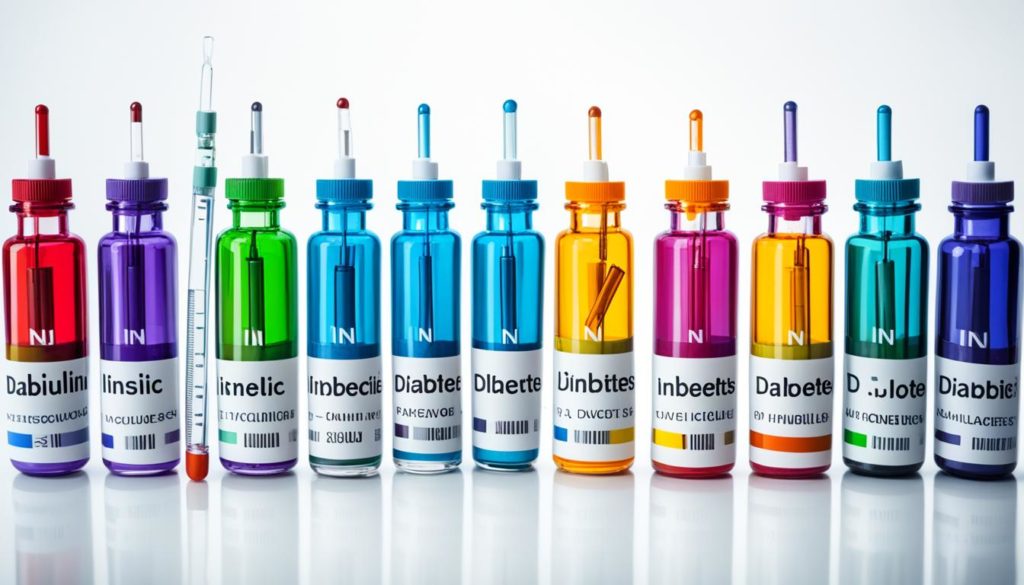About 10% of people in the U.S. have diabetes. While insulin has been a key treatment, there are new options. Now, there are non-insulin diabetes treatments. These can help control your blood sugar in different ways. This means you don’t have to rely only on insulin.
Let’s look into non-insulin diabetes treatments like GLP-1 receptor agonists and SGLT2 inhibitors. These options help manage diabetes without insulin. They also offer benefits like better weight control and less chance of low blood sugar. We’ll also cover their possible risks and the need for a healthy diet and exercise.
Key Takeaways
- Non-insulin diabetes medications offer diverse mechanisms for blood glucose control.
- These therapies provide an alternative for those not achieving success with traditional insulin.
- Different types include GLP-1 receptor agonists and SGLT2 inhibitors.
- Benefits include improved weight management and reduced hypoglycemia.
- Patients must continue a balanced diet and regular exercise to maximize benefits.
What are Non-Insulin Diabetes Injectables?
Non-insulin diabetes injectables are a key choice for those with type 2 diabetes needing extra help to manage blood sugar levels. These meds have different ways to help control glucose, making them vital in diabetes care.
Overview
The diabetes injectables overview shines a light on various non-insulin options other than insulin shots. They’re crucial for people whose blood sugar isn’t well-managed by pills alone. Knowing how these meds work is key to smart diabetes management decisions.
Types of Non-Insulin Injectables
There are different kinds of injectable diabetes meds:
- GLP-1 Receptor Agonists: They act like the GLP-1 hormone, boosting insulin release and blocking glucagon. Trulicity (dulaglutide) and Victoza (liraglutide) are examples.
- Amylin Analogs: Drugs like Symlin (pramlintide) help control blood sugar by slowing digestion and lowering glucagon levels.
- SGLT2 Inhibitors: Mainly pills now, but injectable forms are being studied. These stop sugar reabsorption in the kidneys.
- Dual GLP-1 and GIP Receptor Agonists: A promising new class, like tirzepatide, targeting both GLP-1 and GIP receptors for better blood sugar control.

GLP-1 Receptor Agonists
GLP-1 receptor agonists are a key treatment for type 2 diabetes. They manage blood sugar levels well. These meds stimulate the pancreas to release insulin. They move sugar into the cells and slow digestion.

How They Work
These drugs act like the incretin hormone, increasing insulin when you eat. They slow food leaving the stomach and lessen glucagon, which helps control appetite and sugar levels. So, GLP-1 receptor agonists have major benefits for diabetes treatment without insulin.
Popular GLP-1 Medications
Many GLP-1 receptor agonists are popular and approved for use. Some well-known ones include:
- Liraglutide (Brand name: Victoza) – Taken once a day.
- Exenatide (Brand name: Byetta) – Needed twice a day.
- Dulaglutide (Brand name: Trulicity) – A weekly shot.
- Semaglutide (Brand name: Ozempic) – Given weekly too.
These meds offer different schedules to match people’s lives. They’re usually easy to handle, but some might feel sick or face other issues. Yet, GLP-1 receptor agonists are a top pick for diabetes management without insulin.
Amylin Analogs
Amylin analogs, like pramlintide, play a big role in managing diabetes without needing insulin. These drugs work together with insulin to keep sugar levels in check. By making digestion slower and controlling hunger, they offer a strong way to handle diabetes.
When used before eating, they help a lot in dealing with diabetes. Patients usually end up eating less, which helps in their diabetes care plan.
Even though they are helpful, it’s important to know about side effects. Nausea is the most common issue, which might make it hard for some people to keep using them. Yet, the way they help control sugar and aid in insulin-free diabetes care is a big plus.
To sum up how amylin analogs work compared to insulin, look at this comparison:
| Characteristic | Amylin Analogs | Insulin Therapy |
|---|---|---|
| Mechanism of Action | Slows digestion, controls appetite | Lowers blood sugar by facilitating glucose uptake |
| Administration | Before meals | Varies (mealtime, basal) |
| Primary Benefit | Reduced caloric intake, comprehensive blood sugar control | Direct blood sugar reduction |
| Common Side Effect | Nausea | Hypoglycemia |
SGLT2 Inhibitors: Beyond Oral Medications
SGLT2 inhibitors have changed diabetes care by offering more than just pills. These groundbreaking injectables help the body remove glucose through urine, lowering blood sugar. They also lead to weight loss and better heart and kidney health.
“The introduction of SGLT2 inhibitors has provided clinicians with powerful tools to manage diabetes more effectively, benefiting patients beyond traditional methods,” says Dr. Janet McGill, a specialist in endocrinology and diabetes at Washington University in St. Louis.
Some FDA-approved medications in this class are:
- Canagliflozin (Invokana)
- Dapagliflozin (Farxiga)
- Empagliflozin (Jardiance)
- Ertugliflozin (Steglatro)
These medications are highly effective but have side effects. Genital yeast infections are common in both men and women. Yet, the overall benefits of SGLT2 inhibitors are significant for diabetes management.
Comparative Performance of SGLT2 Inhibitors:
| Medication | Blood Sugar Reduction | Weight Loss | Heart Benefits | Kidney Benefits |
|---|---|---|---|---|
| Canagliflozin | High | Moderate | Moderate | High |
| Dapagliflozin | Moderate | High | High | Moderate |
| Empagliflozin | High | Moderate | High | High |
| Ertugliflozin | Moderate | Moderate | Moderate | Moderate |
SGLT2 inhibitors offer diverse and meaningful benefits for diabetes treatment. They provide a significant alternative to traditional treatments.
Dual GLP-1 and GIP Receptor Agonists
Dual GLP-1 and GIP receptor agonists are a new kind of medicine for diabetes. They help control blood sugar without insulin. These medications combine GLP-1 and GIP effects for better blood sugar management.
Mechanism of Action
These agonists work by making the body release insulin when blood sugar is high. They also slow down how fast the stomach empties. By acting on both GLP-1 and GIP receptors, they help control blood sugar after meals. This also reduces HbA1c levels.
Approved Medications
Tirzepatide stands out among these dual-acting medications. In studies, it’s been effective at managing blood sugar and helping with weight loss. The dose of Tirzepatide varies, based on what each patient needs. Doctors watch how well it works and adjust if necessary.
| Medication | Dosage | Common Side Effects |
|---|---|---|
| Tirzepatide | 5-15 mg weekly | Gastrointestinal discomfort |
Who Can Benefit from Non-Insulin Diabetes Injectables?
Non-insulin diabetes injectables offer a new way to control blood sugar in people with type 2 diabetes. They are great for those who still have high blood sugar even after taking oral meds. Also, they can be good for certain groups of patients.
Type 2 Diabetes Patients
Adults with type 2 diabetes who still have high blood sugar can use these injectables. They work well alongside lifestyle changes and oral meds. Examples include GLP-1 receptor agonists and SGLT2 inhibitors.
These options can lower blood sugar, help lose weight, and protect the heart. To find out more about these medicines, check out this helpful article.
Specific Patient Populations
People with heart and kidney issues can greatly benefit from these diabetes injectables. They help protect the heart and kidneys. But, it’s crucial to know that research is limited for their use in pregnant women and those under 18.
These groups should talk carefully with doctors about the pros and cons before beginning treatment.
Safety and Side Effects
It’s vital to know the safety and possible side effects of non-insulin diabetes injectables. This knowledge helps patients and doctors choose wisely. This part will cover common and long-term safety issues related to these drugs.
Common Side Effects
Non-insulin injectables aim to control blood sugar. Yet, they can cause side effects. Common issues include stomach upset, throwing up, and diarrhea. Reactions at the injection spot, like redness, swelling, and itchiness, can also happen. Knowing the safety of these drugs is key.
Visitthis linkfor more info on how to manage these effects and ensure effective treatment.
Long-Term Safety Concerns
Long-term safety is crucial for non-insulin diabetes injectables. Some studies suggest risks of pancreatitis and thyroid cancer, mainly from animal research. There are also concerns about kidney problems with some drugs. It’s important for patients to understand these diabetes medications side effects.
Doctors stress the need for teaching patients and regular check-ups to tackle these issues. Patients must know about serious warnings on some drugs. They should talk openly with their doctors to fine-tune treatment as needed.
| Type of Side Effect | Examples | Duration | Management Strategies |
|---|---|---|---|
| Gastrointestinal | Nausea, Vomiting, Diarrhea | Short-term | Gradual dose escalation, anti-nausea medications |
| Injection Site Reactions | Redness, Swelling, Itching | Short-term | Rotation of injection sites, topical treatments |
| Serious Concerns | Pancreatitis, Thyroid Cancer, Kidney Issues | Long-term | Regular monitoring, patient education, early detection |
Combining Non-Insulin Injectables with Other Medications
Optimizing blood sugar levels often means using more than one medication. People on non-insulin treatments can add pills to get better results. This strategy makes the treatment more specific to the person. It offers extra control over blood sugar that one medicine might not provide.
One method involves pairing a GLP-1 receptor agonist with a DPP-4 inhibitor. This duo helps boost insulin release and lowers glucagon, which improves blood sugar levels. Also, using SGLT2 inhibitors with metformin can enhance the drop in sugar levels. It helps with weight loss and heart health too.
Here are some common combinations used in practice:
| Combination Therapy | Main Benefits |
|---|---|
| GLP-1 Receptor Agonist + Metformin | Improved glucose control, weight loss |
| SGLT2 Inhibitor + Metformin | Enhanced glycemic control, cardiovascular protection |
| GLP-1 Receptor Agonist + DPP-4 Inhibitor | Synergistic effects on insulin and glucagon |
The idea of using different drugs together is to hit various aspects of sugar control. This way, doctors can tailor treatments to each person’s needs. It leads to more successful management of diabetes.
Benefits Over Traditional Insulin Therapy
Now, managing diabetes doesn’t always mean needing insulin. Non-insulin diabetes injectables offer new hope. They have a lot of benefits over traditional insulin therapy.
Improved Blood Sugar Control
One major benefit is better blood sugar control. Non-insulin injectables, like GLP-1 receptor agonists, regulate glucose more safely. They trigger insulin release only when needed, making diabetes management smoother.
Weight Management
Weight control is another big plus of non-insulin therapies. Unlike insulin, these injectables don’t cause weight gain. For those fighting obesity and type 2 diabetes, this is great news.
Non-insulin diabetes treatments do more than just control blood sugar. They improve patients’ lives by tackling many aspects of diabetes, easing the disease’s impact.
Expert Tips for Managing Non-Insulin Diabetes Injectables
Managing non-insulin injectables well is very important for good diabetes care. We offer expert advice on injection methods, checking blood sugar, and adding diet and exercise for better results.
Injection Techniques
Using the right injection technique is key to the success of non-insulin injectables. It also lessens pain. Make sure to:
- Rotate Injection Sites: Change where you inject to avoid skin problems and damaged tissue.
- Use the Right Needle: Pick the needle size your doctor suggests.
- Avoid Injecting into Muscles: Put injections in fatty areas instead of muscles for improved medicine uptake.
- Consult Experts: Get advice from diabetes educators to learn the best ways to inject.
Monitoring Blood Sugar Levels
Keeping an eye on your blood sugar is a big part of managing diabetes with non-insulin injectables. Keep in mind:
- Regular Testing: Test your sugar as your doctor advises so you can adjust your doses as needed.
- Log Results: Write down your sugar levels to spot trends and make smart choices.
- Stay Informed: Use tech that works with your devices for up-to-date sugar level info.
Diet and Exercise Considerations
Diet and exercise are vital in making your non-insulin injectables work better. Remember to:
- Balanced Diet: Eat different healthy foods to keep your sugar level steady.
- Exercise Regularly: Stay active to boost how well your body uses insulin and to stay healthy.
- Consult Professionals: Talk to dietitians and trainers who understand diabetes for customized plans.
Following these expert suggestions can improve your use of non-insulin injectables and help in managing your diabetes effectively.
Conclusion
Non-insulin diabetes injectables are key in modern diabetes care. They help patients control their blood sugar better. They also make it easier for people to stick to their medication plan. This leads to more people being happy with their treatment.
Choosing these treatments depends on the patient. Doctors must look at the patient’s health history and how they live their life. They also need to see how the patient responds to treatment. The possible benefits are big, but we must keep researching. We need to make sure these treatments are safe for everyone over time.
Keeping up with the latest in non-insulin diabetes injectables is vital. It helps patients and doctors make the best choices for treatment without insulin. This leads to success in the short term and better health in the long term. With more research and education for patients, we can improve the way we treat diabetes.
FAQ
What are non-insulin diabetes injectables?
These medications help control blood sugar in type 2 diabetes when other treatments fall short. They work in different ways like triggering insulin release and controlling hunger.
What types of non-insulin diabetes injectables are available?
We have GLP-1 receptor agonists, amylin analogs, SGLT2 inhibitors, and combined GLP-1 and GIP receptor agonists. Each type lowers blood sugar differently.
How do GLP-1 receptor agonists work?
GLP-1 receptor agonists make the pancreas release insulin. They also help sugar enter cells and slow down digestion. Drugs like liraglutide and exenatide are popular examples.
What are some common side effects of non-insulin diabetes injectables?
You might face nausea, vomiting, and diarrhea. More serious risks include pancreatitis and, based on animal studies, a possible thyroid cancer risk.
Can non-insulin diabetes injectables be used during pregnancy?
Their safety during pregnancy isn’t well-known. It’s vital for those who are pregnant or planning to talk with their doctor first.
What are the benefits of using non-insulin injectables over traditional insulin therapy?
Non-insulin injectables lower the risk of low blood sugar and can also help with weight management. They improve life quality.
Who are the ideal candidates for non-insulin diabetes injectables?
Those with type 2 diabetes not helped by other treatments, especially with heart and kidney diseases, might benefit. Each patient’s situation is considered.
What should patients know about combining non-insulin injectables with other medications?
Mixing them with oral drugs can better control glucose. This strategy depends on each person’s unique health needs.
Are there long-term safety concerns with non-insulin diabetes injectables?
Yes, long-term effects might include pancreatitis and kidney problems. Ongoing education and check-ups are key for safe use.
How can patients effectively manage diabetes with non-insulin injectables?
Good management means learning to inject with less pain, checking blood sugar often, and sticking to diet and exercise plans for best results.
What is the role of non-insulin diabetes injectables in contemporary diabetes management?
They’re key for modern diabetes care, offering an insulin alternative. They boost treatment sticking, happiness, and tailored care.


